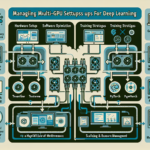Setting up GPU-based inference pipelines for real-time applications involves several key steps, ranging from hardware selection to software optimization. Below is a comprehensive guide tailored for an IT manager with responsibility for infrastructure, servers, virtualization, and AI:
1. Hardware Setup
- GPU Selection: Choose GPUs optimized for inference workloads. NVIDIA GPUs like A100, T4, or RTX 3090/4090 are ideal depending on workload size and budget.
- Server Configuration: Ensure your servers have adequate PCIe lanes, cooling, and power supply to support GPUs. For high-density GPU setups, consider servers with multiple GPU slots (e.g., NVIDIA DGX systems or Supermicro GPU servers).
- Networking: For real-time applications, low-latency networking is critical. Use high-speed NICs like 10GbE or 100GbE and consider RDMA-capable networks (e.g., InfiniBand).
- Storage: Use high-speed NVMe SSDs for fast data access. If your model requires large datasets, ensure your storage solution can handle high IOPS.
2. Software and Frameworks
- GPU Drivers: Install the latest NVIDIA GPU drivers and CUDA toolkit on the host machines.
- Inference Frameworks: Use frameworks optimized for GPU inference, such as:
- TensorRT: NVIDIA’s high-performance library for optimizing neural networks for inference.
- ONNX Runtime: Supports models in the ONNX format, and can leverage GPU acceleration.
- PyTorch/TensorFlow: Both frameworks support GPU inference, but for production, TensorRT or ONNX Runtime is often preferred.
- Containerization: Use Docker containers to isolate and deploy inference pipelines. NVIDIA provides optimized containers via NGC (NVIDIA GPU Cloud).
3. Model Optimization
- Quantization: Convert models to lower-precision (e.g., FP16 or INT8) to reduce computational requirements while maintaining acceptable accuracy.
- Pruning: Remove unnecessary parameters from the model to reduce size and inference latency.
- Batching: Optimize inference batch sizes to balance latency and throughput based on your application requirements.
4. Virtualization and Kubernetes
- GPU Virtualization:
- Use NVIDIA vGPU technology to share GPUs across multiple virtual machines if needed.
- Kubernetes Integration:
- Deploy inference pipelines in a Kubernetes cluster using GPU-enabled nodes.
- Install the NVIDIA Kubernetes device plugin to enable GPU usage within pods.
- Use Helm charts or custom YAML configurations to manage the deployment of inference services.
- Autoscaling: Configure Kubernetes Horizontal Pod Autoscaler (HPA) based on CPU/GPU utilization or inference request rates.
5. Real-Time Application Setup
- Low-Latency Communication:
- Use gRPC or REST APIs for communication between your real-time application and inference service.
- Enable GPU direct RDMA for low-latency data transfer between GPUs and network.
- Streaming:
- For video or audio applications, use frameworks like FFmpeg integrated with your inference pipeline.
- Load Balancing:
- Use load balancers to distribute inference requests across multiple GPUs or nodes.
6. Monitoring and Optimization
- Telemetry and Monitoring:
- Use tools like NVIDIA DCGM (Data Center GPU Manager) for GPU monitoring.
- Integrate monitoring with Prometheus and Grafana to visualize GPU utilization, inference latency, and other metrics.
- Profiling:
- Use NVIDIA Nsight Systems or TensorFlow/PyTorch Profiler to identify bottlenecks.
- Scaling and Failover:
- Set up scaling policies in Kubernetes based on demand.
- Implement failover mechanisms to ensure high availability.
7. Security
- Data Encryption: Encrypt data in transit using TLS and at rest using disk encryption.
- Access Controls: Restrict access to GPU resources and inference APIs using role-based access control (RBAC).
- Isolation: Use container isolation or virtual machines for multi-tenant environments.
8. Testing and Deployment
- Stress Testing: Simulate real-time workloads to test GPU utilization and latency under peak conditions.
- A/B Testing: Deploy multiple versions of your inference pipeline to test performance improvements.
- CI/CD Pipelines: Automate deployment of updated models and code using CI/CD workflows integrated with Kubernetes.
9. Documentation and Training
- Document the architecture and operational procedures.
- Train your team to maintain and optimize the pipeline, including GPU-specific troubleshooting.
By following these steps, you can set up an efficient GPU-based inference pipeline for real-time applications, leveraging the power of GPUs to achieve low latency and high throughput. If you need more specific recommendations on tools or configurations, feel free to ask!


